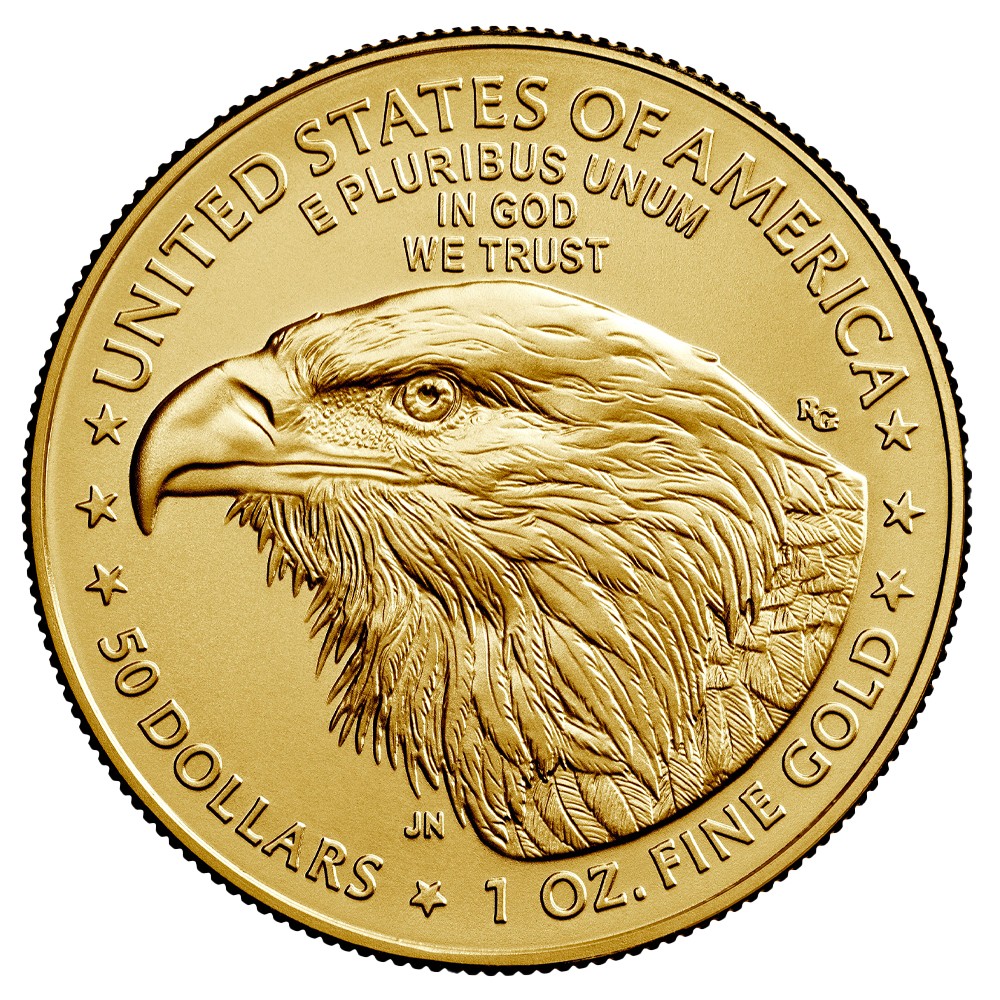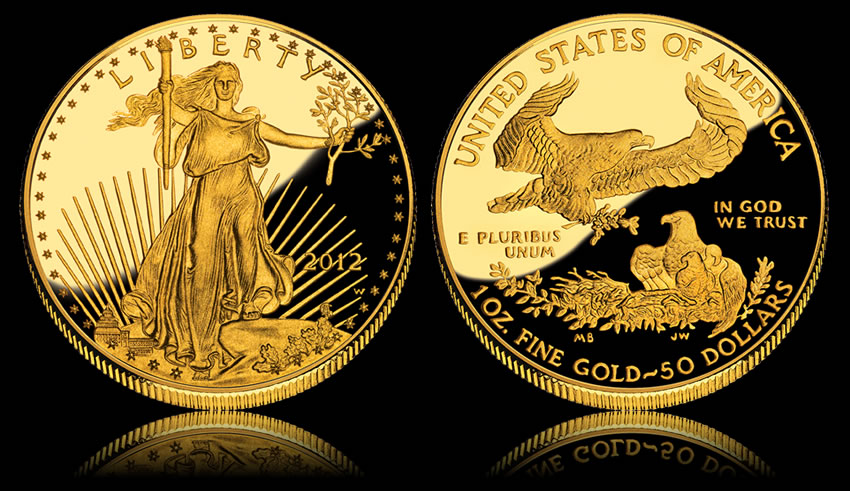The American Eagle Gold Coin is a series of gold bullion coins produced by the United States Mint. Introduced in 1986, these coins have been minted in four sizes: 1/10 oz, 1/4 oz, 1/2 oz, and 1 oz, each with corresponding denominations of $5, $10, $25, and $50 respectively.
The design of these coins is highly symbolic of American identity. The obverse, or front, of the coin showcases a version of Augustus Saint-Gaudens‘ full-length figure of Lady Liberty with flowing hair, holding a torch in her right hand and an olive branch in her left. This image was originally created for the double-eagle gold piece minted from 1907 to 1933, and is widely regarded as one of the most beautiful designs in American coinage.
The reverse, or back, of the coin features a design by sculptor Miley Busiek. This design depicts a male bald eagle carrying an olive branch flying above a nest containing a female eagle and their hatchlings. This not only symbolizes family but also emphasizes the American ideals of freedom and unity. Before diving in, feel free to have a look at our article on another type of collections: stamps! And learn how to appraise a stamp collection.
The American Eagle Gold Coins are not only valuable for their gold content but also for their collectibility. They are sought after by both investors who are looking for a reliable store of value and by numismatists who appreciate the beauty and historical significance of the coin designs. Maybe it’s the time for you to start a coin collection?
History of the American Eagle Gold Coin
The history of the American Eagle Gold Coin is deeply intertwined with the history of the United States and its monetary system.
The Gold Standard and Predecessor Coins
Before the American Eagle Gold Coin was minted, the United States operated under the gold standard, which backed the value of U.S. currency with gold reserves. In this era, several different gold coins were minted, including the Double Eagle and the Gold Eagle, which were worth $20 and $10 respectively.
The Double Eagle, minted from 1850 to 1933, featured a design by Augustus Saint-Gaudens that is now iconic. The obverse showed Lady Liberty holding a torch and olive branch, with the Capitol building in the background, while the reverse featured a majestic bald eagle in flight.
End of the Gold Standard and the Bullion Act of 1985
However, during the Great Depression, in a bid to combat deflation, President Franklin D. Roosevelt took the United States off the gold standard in 1933. He issued an executive order requiring all gold coins, gold bullion, and gold certificates to be turned into the government.
This move effectively halted the minting of gold coins in the United States until decades later when the Bullion Act of 1985 was passed. The act allowed the U.S. Mint to produce gold and silver bullion coins for investment purposes. The American Eagle Gold Coin was created as a result of this legislation.
Introduction of the American Eagle Gold Coin
The first American Eagle Gold Coins were minted and released in 1986. They were available in four sizes: 1/10 oz, 1/4 oz, 1/2 oz, and 1 oz, with face values of $5, $10, $25, and $50 respectively.

The design for the American Eagle Gold Coin drew from the nation’s past, specifically the Double Eagle coin. The obverse side of the coin features the full-length figure of Lady Liberty from the Double Eagle, while the reverse side, designed by sculptor Miley Busiek, shows a family of bald eagles, symbolizing family tradition and unity.
Recent Developments
Over the years, the American Eagle Gold Coin has been minted in both bullion and proof versions, with the proof version intended for collectors. It has become one of the world’s leading gold bullion investment coins, celebrated for its beauty, its exact gold content, and its backing by the U.S. government.
In 2021, to commemorate the 35th anniversary of the program, the U.S. Mint unveiled a new reverse design for the coin, created by Jennie Norris. The new design features a close-up portrait of an eagle.
The American Eagle Gold Coin, from its historical origins to its current iterations, stands as a testament to the enduring quality and craftsmanship of the United States Mint and the timeless allure of gold.
Design and Symbolism
The American Eagle Gold Coin is a staple of United States Mint’s product offerings, and a powerful symbol of America’s longstanding commitment to quality minting and sound money. First minted in 1986, these gold bullion coins have become one of the world’s leading gold bullion investment coins, renowned for their beauty, reliability, and precise gold content.

Obverse Design
The obverse design of the American Eagle Gold Coin is adapted from the Augustus Saint-Gaudens’ design of Lady Liberty, originally used for the double-eagle gold piece that was minted from 1907 to 1933. This image features a full-length figure of Liberty in full stride with flowing hair, holding a torch in her right hand, symbolizing enlightenment, and an olive branch in her left, signifying peace. The United States Capitol building is also visible in the left background, while the year of minting is inscribed below Liberty.
Reverse Design
On the reverse of the coin, there is an original design by American sculptor Miley Busiek. It depicts a male bald eagle in flight, carrying an olive branch to a nest containing a female eagle and her eaglets. The scene represents American family values and unity, with the bald eagle – a national emblem – signifying strength and freedom. The reverse also includes the phrases “E PLURIBUS UNUM” (Out of Many, One) and “IN GOD WE TRUST,” as well as the denomination and weight of the coin.
Buying and Selling American Eagle Gold Coins
American Eagle Gold Coins can be purchased and sold through a variety of methods. Here’s a breakdown of how to buy and sell these coins:
1. Buying American Eagle Gold Coins
a. Authorized Dealers: The U.S. Mint does not sell American Eagle Gold Coins directly to the public. Instead, they distribute their coins to a network of authorized purchasers, which includes coin dealers, precious metal firms, brokerage companies, and participating banks. You can find a list of these authorized dealers on the U.S. Mint’s website.
b. Online Marketplaces: Online platforms like eBay also offer American Eagle Gold Coins for sale. However, caution should be exercised when using these platforms due to the risk of counterfeits.
c. Coin Shows: Coin shows and conventions are another place where you can buy American Eagle Gold Coins. These events bring together numerous coin dealers, and you can often find a wide variety of coins for sale.
d. Auctions: Some high-end auction houses will have lots that include American Eagle Gold Coins, especially if they are of a particularly high grade or are a part of a complete set.
2. Selling American Eagle Gold Coins
a. Local Coin Shops: One of the most straightforward ways to sell your American Eagle Gold Coins is to take them to a local coin shop. The dealer can physically examine your coins and give you a price based on their condition and the current gold spot price.
b. Online Dealers: There are numerous online dealers who will buy American Eagle Gold Coins. You’ll need to ship your coins to the dealer, who will then assess their value and make you an offer.
c. Peer-to-Peer: You can also sell your coins directly to other individuals using online marketplaces like eBay. Keep in mind that these platforms usually charge a fee for their services.
d. Auction Houses: If you have particularly valuable American Eagle Gold Coins, you might consider selling them through an auction house. This could potentially net you a higher price, especially if two bidders get into a bidding war over your coins.
In both buying and selling American Eagle Gold Coins, it’s important to be aware of the current spot price of gold. This price, which fluctuates throughout the trading day, serves as a benchmark for determining the value of gold coins. However, keep in mind that dealers often charge a premium over the spot price when selling gold coins, and offer less than the spot price when buying them.
Finally, as with any investment, it’s important to do your research and consider seeking advice from financial advisors or professionals in the field of precious metals investing.
Build a portfolio with American Eagle Gold Coins
Creating a portfolio of American Eagle Gold Coins worth $1,000 with four coins would likely involve purchasing smaller denomination coins due to their lower value. As before, let’s assume the spot price of gold is $1,800 per ounce, and there is a 5% dealer premium.
Here’s an example of how your portfolio could look:
| Coin | Face Value | Gold Content | Value at Spot Price | Value with 5% Premium | Quantity | Total Value |
|---|---|---|---|---|---|---|
| 1/4 oz American Eagle Gold Coin | $10 | 1/4 oz | $450 | $472.50 | 1 | $472.50 |
| 1/10 oz American Eagle Gold Coin | $5 | 1/10 oz | $180 | $189 | 3 | $567 |
| Total | $1,039.50 |
In this scenario, you have a single 1/4 oz coin and three 1/10 oz coins, for a total of four coins and a total value of roughly $1,039.50, slightly above the $1,000 target due to the dealer premium.
Remember, prices can fluctify based on the spot price of gold and dealer premiums. Always verify the latest prices before making any purchases. Moreover, investing in gold should be part of a diversified investment strategy, and it’s often advisable to consult with a financial advisor before making investment decisions.
Conclusion
In conclusion, the American Eagle Gold Coin is not only a symbol of the United States’ storied history and commitment to quality minting, but it’s also a versatile investment option for those seeking to diversify their portfolios with precious metals. Its design pays tribute to the nation’s past while meeting the modern needs of investors and collectors alike.
Buying and selling American Eagle Gold Coins can be achieved through various methods, including authorized dealers, online marketplaces, coin shows, and auctions. Additionally, constructing a portfolio with these coins allows for flexibility depending on one’s budget and investment goals.
However, as with any investment, careful research and consideration should be employed before making any decisions. Spot prices and dealer premiums can fluctify, making it essential to stay updated with the current market conditions. Consulting with financial advisors or professionals experienced in precious metals investing is often advisable.
Throughout its history, from the gold standard era to its reintroduction in 1986 and recent design updates, the American Eagle Gold Coin continues to hold significant value and appeal for investors and collectors worldwide. It stands as a testament to the U.S.’s monetary history and a beacon for those seeking stability in tangible assets in the ever-evolving financial landscape.
